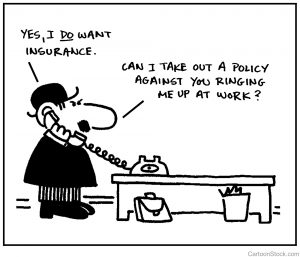Is Cold Calling Really Dead?
 In these times where the big buzz term is “Social Selling, ” cold calling has been deemed unproductive and is therefore, apparently, approaching its expiry date.
In these times where the big buzz term is “Social Selling, ” cold calling has been deemed unproductive and is therefore, apparently, approaching its expiry date.
I don’t agree and wonder why the statement “cold calling is dead” has so many supporters?
Let’s start out by defining what the term “cold calling” means.
Calling people you don’t know makes most people crumble
I think there are two reasons why cold calling is not particularly attractive:
- Most people hate calling people they don’t know. It ranks as high on the hate-list as making public presentations.
- Most people have experienced being cold-called by hopeless sales people that offered something completely irrelevant in a very intrusive and unpleasant way.
Therefore most people hate making and most people hate receiving cold calls. They wish that cold-calling could just disappear.
Cold calling can be very pleasant, and it works
Let me give you two examples today (I will follow up with more examples in the future).
Doormat subscriptions
 I had an appointment with my physiotherapist the other day. While I was waiting in the reception two very well-dressed people came in and asked the receptionist who was responsible for managing the clinic. They explained what they wanted to talk about and after a few minutes the owner came out. After my session and on the way out I met the well-dressed people again and asked them what they did.
I had an appointment with my physiotherapist the other day. While I was waiting in the reception two very well-dressed people came in and asked the receptionist who was responsible for managing the clinic. They explained what they wanted to talk about and after a few minutes the owner came out. After my session and on the way out I met the well-dressed people again and asked them what they did.
They sold doormat subscriptions.
The service includes a set of new doormats with the customer’s logo. Depending on the circumstances the doormats would be cleaned and replaced at regular intervals.
They sell the service by making unsolicited calls in person. As soon as they enter a building or a shop they can see if the potential customer needs what they offer. They very seldom sell a subscription on the first call. Instead, they build a pipeline and move leads forward by nursing and follow-up.
Of the two people I met, one was a sales-trainee and the other the supervisor. Later in the day, I had a phone conversation with the supervisor.
This is what he told me.
- The sales people are freelancers on 100% commission, but within the exclusivity of a district. They are in charge of their own time but are offered supervision and coaching from the company.
- It takes 3-6 months to build your base in a district. Then the revenue should begin to flow at a steady rate.
- Out of a hundred new sales trainees, only a few will have what it takes regarding personality, patience, perseverance, and structure. There is more paperwork and planning required than meets the eye when you make field calls.
- The average earning for the salesforce is $10K a month.
- Doing your homework is allowed.
- Doing cold calls in person is the best way to build the pipeline. After the first contact nursing and follow-up can be done in person and through emails and phone calls.
Selling books to bookstores
My new book is out. It’s the first I have written in Danish. It is a business biography, and it’s the first one of its kind.
Not all bookstores automatically order the book from the distributor and put it on their shelves. So I call or show up in the bookstores in my vicinity and check if they have the book in stock. If not then I offer them a good deal.
The conversation takes less than 10 minutes, and my hit-rate so far is 100%.
Cold calling doesn’t require you to have your head in the sand
The definition of cold calling doesn’t say that you have to call out of and into the blue. It doesn’t say how the call should be made (knocking on doors, sending emails, InMails, Twitter DM, making a phone call, etc.). And it doesn’t say how you should prepare and make the contact. It just states that the salesperson has had no prior contact with the potential customer.
You do not fall outside the definition if you think first and do some homework.
Market research and segmentation
![]() According to the definition, nothing is prohibiting a company from filtering its call list carefully. By investing a little time, a marketing department can produce a list of leads (potential customers) that match a set of criteria that have shown to be good indicators for people who are receptive to the company’s value proposition. They can even refine the list only to include potential customers that have shown a direct interest in what the company has to offer. Such indicators of interest can be visits to the website, signing up for a newsletter, downloading a whitepaper, liking, sharing or commenting on a social media post, or some other indications of a pulse.
According to the definition, nothing is prohibiting a company from filtering its call list carefully. By investing a little time, a marketing department can produce a list of leads (potential customers) that match a set of criteria that have shown to be good indicators for people who are receptive to the company’s value proposition. They can even refine the list only to include potential customers that have shown a direct interest in what the company has to offer. Such indicators of interest can be visits to the website, signing up for a newsletter, downloading a whitepaper, liking, sharing or commenting on a social media post, or some other indications of a pulse.
However, the more criteria you introduce, the shorter the list will be. For many companies, the list is empty, because they do no marketing.
Prospect research
According to the definition, nothing is prohibiting a company (or the salesperson) from examining each entry on the potential call list and digging up some background information before making the call. The definition doesn’t prevent you from investing an hour, a day, a week, a month or a year of research before sending an email or making a phone call.
It all comes down to the RoI
Deciding if, how, where and when you should use cold calling is a matter of designing the most efficient revenue generation process. For many companies that means having a step where sales development people (or salespeople) reach out to people with whom they have had no previous contact. Without this step, a lot of companies could not survive.
–ooOoo–
Read more posts by Hans Peter Bech









